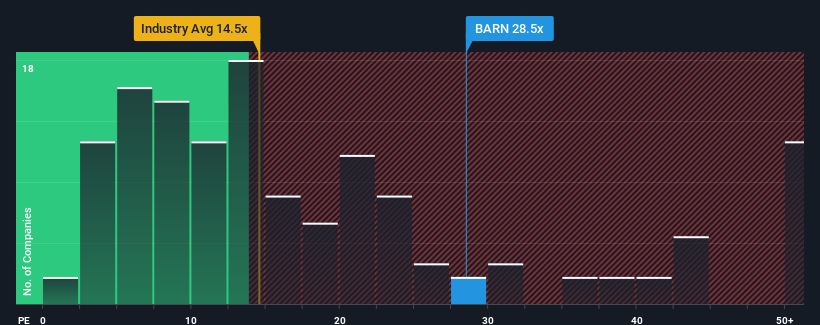
Barry Callebaut AG's (VTX:BARN) price-to-earnings (or "P/E") ratio of 28.5x might make it look like a sell right now compared to the market in Switzerland, where around half of the companies have P/E ratios below 21x and even P/E's below 13x are quite common. However, the P/E might be high for a reason and it requires further investigation to determine if it's justified.
Barry Callebaut hasn't been tracking well recently as its declining earnings compare poorly to other companies, which have seen some growth on average. It might be that many expect the dour earnings performance to recover substantially, which has kept the P/E from collapsing. If not, then existing shareholders may be extremely nervous about the viability of the share price.
Check out our latest analysis for Barry Callebaut

Does Growth Match The High P/E?
There's an inherent assumption that a company should outperform the market for P/E ratios like Barry Callebaut's to be considered reasonable.
Retrospectively, the last year delivered a frustrating 23% decrease to the company's bottom line. The last three years don't look nice either as the company has shrunk EPS by 8.3% in aggregate. Accordingly, shareholders would have felt downbeat about the medium-term rates of earnings growth.
Turning to the outlook, the next three years should generate growth of 25% each year as estimated by the eleven analysts watching the company. With the market only predicted to deliver 10% per annum, the company is positioned for a stronger earnings result.
With this information, we can see why Barry Callebaut is trading at such a high P/E compared to the market. It seems most investors are expecting this strong future growth and are willing to pay more for the stock.
What We Can Learn From Barry Callebaut's P/E?
Using the price-to-earnings ratio alone to determine if you should sell your stock isn't sensible, however it can be a practical guide to the company's future prospects.
We've established that Barry Callebaut maintains its high P/E on the strength of its forecast growth being higher than the wider market, as expected. At this stage investors feel the potential for a deterioration in earnings isn't great enough to justify a lower P/E ratio. It's hard to see the share price falling strongly in the near future under these circumstances.
It is also worth noting that we have found 4 warning signs for Barry Callebaut (2 are potentially serious!) that you need to take into consideration.
If these risks are making you reconsider your opinion on Barry Callebaut, explore our interactive list of high quality stocks to get an idea of what else is out there.
Valuation is complex, but we're here to simplify it.
Discover if Barry Callebaut might be undervalued or overvalued with our detailed analysis, featuring fair value estimates, potential risks, dividends, insider trades, and its financial condition.
Access Free AnalysisHave feedback on this article? Concerned about the content? Get in touch with us directly. Alternatively, email editorial-team (at) simplywallst.com.
This article by Simply Wall St is general in nature. We provide commentary based on historical data and analyst forecasts only using an unbiased methodology and our articles are not intended to be financial advice. It does not constitute a recommendation to buy or sell any stock, and does not take account of your objectives, or your financial situation. We aim to bring you long-term focused analysis driven by fundamental data. Note that our analysis may not factor in the latest price-sensitive company announcements or qualitative material. Simply Wall St has no position in any stocks mentioned.
Have feedback on this article? Concerned about the content? Get in touch with us directly. Alternatively, email editorial-team@simplywallst.com
About SWX:BARN
Barry Callebaut
Engages in the manufacture and sale of chocolate and cocoa products.
Moderate with moderate growth potential.
Similar Companies
Market Insights
Community Narratives



